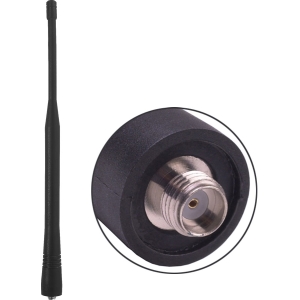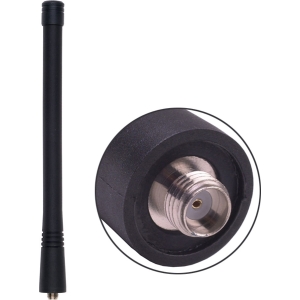Which portable radio antenna would work better (transmit and receive) at a 155 MHz frequency?:
1. A "standard" rubber ducky antenna with a stated bandwidth of 151-159 MHz.
2. A "wideband" rubber ducky antenna with a stated bandwidth of 136-174 MHz.
I periodically check the radio antennas as they come through my office.
Recently I had a couple of PD radios with the "high gain" VHF antennas, a few with the "standard" antennas and a few with stubby antennas.
My own "shop" radio has the wide band antenna on it.
All antennas are the Kenwood offered models.
A while back I had someone drop off a bunch of old radios in my office that they were getting rid of. One of them was an old beat up TK-290 hand held. Since it already had the guts removed, I took it apart and soldered a length of coax onto the antenna jack and had it come out the bottom of the radio chassis. Works well for simulating real world use. I can hook it up to the analyzer and see how the antenna is doing.
The Kenwood wide band VHF antenna is truly wide band. It showed 2.0:1 SWR across the band from about 145 to about 165MHz. Lowest SWR was at about 158MHz at 1.8:1.
I know, SWR not the best estimate tool for antenna performance.
The high gain Kenwood VHF whips had lower SWR but a much narrower bandwidth. Good for 150-160MHz, outside that range the SWR went up quickly.
The standard VHF whip and the stubby VHF whips were nearly identical SWR wise.
Of course SWR doesn't tell you how well the antenna is working. As stated, a 50Ω dummy load shows a near perfect SWR across the band....
Trying out the different antennas on the same radio, it was hard to tell the difference between the wide band, standard and high gain antennas. The Kenwood's have a "maintenance" mode where it will show you receive signal strength in dB. Hardly any difference between those 3 antennas, but that has a lot to do with the system I was testing it with.
The stubby was worse, as expected, but the officers like them when working plain clothes as it's easier to hide the radio.
I'd agree, don't get too hung up on portable antennas. Skip the cute stubby antennas, but find one that's tuned properly for where you plan on transmitting. If you are using a reputable brand antenna, and your expectations are realistic, you'll probably be OK.
In your shoes, I'd say go with the narrow bandwidth antenna if it's where you need it.



